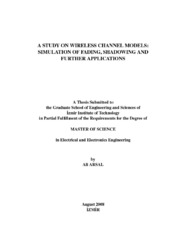Please use this identifier to cite or link to this item:
https://hdl.handle.net/11147/3527Full metadata record
| DC Field | Value | Language |
|---|---|---|
| dc.contributor.advisor | Özen, Serdar | - |
| dc.contributor.author | Arsal, Ali | - |
| dc.date.accessioned | 2014-07-22T13:51:44Z | - |
| dc.date.available | 2014-07-22T13:51:44Z | - |
| dc.date.issued | 2008 | - |
| dc.identifier.uri | http://hdl.handle.net/11147/3527 | - |
| dc.description | Thesis (Master)--Izmir Institute of Technology, Electronics and Communication Engineering, Izmir, 2008 | en_US |
| dc.description | Includes bibliographical references (leaves: 61-63) | en_US |
| dc.description | Text in English; Abstract: Turkish and English | en_US |
| dc.description | x, 63 leaves | en_US |
| dc.description.abstract | In this thesis, we simulate multipath fading which is assumed to have Rayleigh or Rician distribution under the non-line-of sight or line-of-sight condition respectively; as well as spatial shadowing process, assumed to be log-normally distributed. We propose a low-complexity high performance Rayleigh fading simulator, an autoregressive moving average (ARMA)(3,3) model. This proposed method is a variant of the method of filtering of the white Gaussian noise where the filter design is accomplished in the analog domain and transferred into the digital domain. The proposed model is compared with improved Jakes. model, autoregressive (AR) filtering and inverse discrete Fourier transform (IDFT) techniques, in performance and computational complexity. The proposed method outperforms AR(20) filter and modified Jakes. generators in performance. Although IDFT method achieves the best performance, it brings a significant cost in storage which is undesirable.The proposed method achieves high performance with the lowest complexity.Additionally, we apply the quantized filter extension of our proposed filter design, since quantized filters are generally used in hardware implementations due to their minimum power consumption, minimum heat generation and their computational efficiency. We simulate spatial shadowing process, via the simulation method proposed by Patzold and Nguyen. This method is derived from a reference model by using the sum of sinusoids principle. There are two methods enabling the fitting of the simulation model to the reference model with respect to the probability density function (pdf) of the received signal strength as well as to a given autocorrelation function with a decaying exponential shape.Furthermore we use our predicted autocorrelation function obtained via the site-specific radio propagation prediction software named Wireless InSite in order to determine the model parameters. | en_US |
| dc.language.iso | en | en_US |
| dc.publisher | Izmir Institute of Technology | en_US |
| dc.rights | info:eu-repo/semantics/openAccess | en_US |
| dc.subject.lcc | TK5103.2 A781 2008 | en |
| dc.subject.lcsh | Wireless communication systems | en |
| dc.subject.lcsh | Radio--Transmitter and transmission--Fading | en |
| dc.subject.lcsh | Shadowing (Differentiable dynamical systems) | en |
| dc.title | A Study on Wireless Channel Models: Simulation of Fading, Shadowing and Further Applications | en_US |
| dc.type | Master Thesis | en_US |
| dc.institutionauthor | Arsal, Ali | - |
| dc.department | Thesis (Master)--İzmir Institute of Technology, Electrical and Electronics Engineering | en_US |
| dc.relation.publicationcategory | Tez | en_US |
| dc.identifier.wosquality | N/A | - |
| dc.identifier.scopusquality | N/A | - |
| item.openairecristype | http://purl.org/coar/resource_type/c_18cf | - |
| item.languageiso639-1 | en | - |
| item.openairetype | Master Thesis | - |
| item.grantfulltext | open | - |
| item.fulltext | With Fulltext | - |
| item.cerifentitytype | Publications | - |
| Appears in Collections: | Master Degree / Yüksek Lisans Tezleri | |
Files in This Item:
| File | Description | Size | Format | |
|---|---|---|---|---|
| T000671.pdf | MasterThesis | 1.12 MB | Adobe PDF |  View/Open |
CORE Recommender
Page view(s)
30,524
checked on Mar 31, 2025
Download(s)
274
checked on Mar 31, 2025
Google ScholarTM
Check
Items in GCRIS Repository are protected by copyright, with all rights reserved, unless otherwise indicated.